Mars tugs at the human imagination like no other planet. With a force mightier than gravity, it attracts the eye to the shimmering red presence in the clear night sky – John Noble Wilford, Mars Beckons
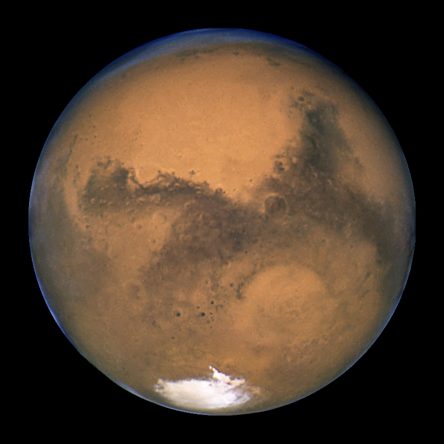
Of all the planets in our solar system, Mars holds a special fascination for us. Upon its dusty red surface, we have projected our fears, our insatiable curiosity, and our hopes for a better tomorrow. We have revered it as a god, had nightmares about being invaded by its inhabitants, sent robotic emissaries to explore it, and maintained dreams of colonizing it. In my own lifetime, I have seen Mars go from being a place of the imagination to becoming an actual, physical destination, a place where I may yet live to see human beings set foot upon and explore.
Given that Mars is the only other rocky world upon which we can see surface features with a telescope, the planet also holds a particular allure for backyard stargazers. But viewing Mars through a telescope can be a challenge. It’s very small, only half the size of the Earth, and its small disc is susceptible to atmospheric distortions, making most telescopic views very disappointing to say the least. The best time to observe Mars is at opposition, when it is close, bright, and appears largest in a telescope.
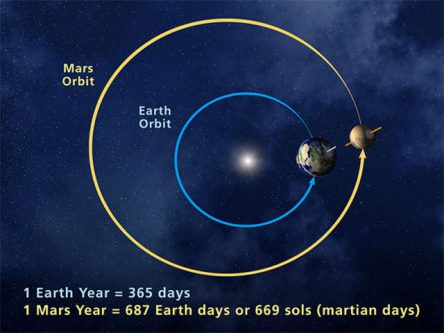 We all know that Earth and Mars orbit around the Sun, but they do so at different speeds. For every two trips we make around the Sun, Mars only completes one. This means that, for most of the time, the two planets are each on different sides of the Sun with respect to one another and, thus, very far apart. Looking “down” upon the solar system, you would usually see a configuration like this: Mars->Sun->Earth. But there are times when the Earth “catches up” with Mars in its orbit and the two planets are very close to each other. During these times, the configuration changes to Sun->Earth->Mars. We call such an alignment, an “opposition” and Mars only comes into opposition every 26 months.
We all know that Earth and Mars orbit around the Sun, but they do so at different speeds. For every two trips we make around the Sun, Mars only completes one. This means that, for most of the time, the two planets are each on different sides of the Sun with respect to one another and, thus, very far apart. Looking “down” upon the solar system, you would usually see a configuration like this: Mars->Sun->Earth. But there are times when the Earth “catches up” with Mars in its orbit and the two planets are very close to each other. During these times, the configuration changes to Sun->Earth->Mars. We call such an alignment, an “opposition” and Mars only comes into opposition every 26 months.
Okay, that all sounds straightforward enough but now I’m going to throw another term at you: “perihelion”. Perihelion is when a planet reaches a point in its orbit where it is closest to the Sun. Keep in mind, that an opposition can occur at any point in a planet’s orbit but when it happens to coincide with perihelion, it gets even closer to us than usual. On average, Mars is about 140 million miles away, but at the end of this month, the Red Planet will be a mere 35.8 million miles distant. This is the closest it has been since August of 2003 when it was 34.6 million miles away, and that was the closest Mars had been to the Earth in nearly 60,000 years (due to Mars’ highly elliptical orbit, these approaches can vary anywhere from 34 million to 63 million miles). These extreme close approaches occur in cycles separated 15 or 17 years apart, so we only get a handful of such opportunities in our lifetimes to see Mars this close and this bright.
WHEN AND WHERE TO LOOK
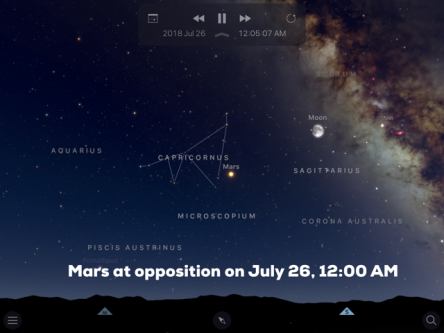 During the first half of July, Mars will not rise above the southeastern horizon until about 2 hours after sunset. This rise time gradually shortens as the month progresses and when it reaches opposition on the nights of July 26-27, you can expect to see it rising less than half an hour after sunset. Early on in the month, Mars shines at a brilliant -2.2 magnitude and it reaches its peak brilliance at opposition, when it will glow a very bright -2.8. In a telescope, Mars starts out July with a disc size of 21 arcseconds. When astronomers measure things upon the sky they use angular degrees. The full moon for example has an angular diameter equivalent to a half a degree. To go smaller, they use arcminutes and arcseconds. One degree is divided into 60 arcminutes and each arcminute is then divided into 60 arcseconds. In a telescope, Jupiter is about 40 or 50 arcseconds across (this month, it shrinks from 41 to 38 arcseconds), so Mars, even at its very best, is going to be small. By the end of the month, Mars will have obtained its greatest disc size of 24.3 arcseconds. By the way, don’t believe the emails and memes that circulate around this time about Mars appearing the same size as a full moon in our night sky. Not gonna happen. If Mars ever looks the size of the full moon it will mean one of two things: either you are in a spaceship headed there or something has gone horribly wrong with gravity and we are all going to die.
During the first half of July, Mars will not rise above the southeastern horizon until about 2 hours after sunset. This rise time gradually shortens as the month progresses and when it reaches opposition on the nights of July 26-27, you can expect to see it rising less than half an hour after sunset. Early on in the month, Mars shines at a brilliant -2.2 magnitude and it reaches its peak brilliance at opposition, when it will glow a very bright -2.8. In a telescope, Mars starts out July with a disc size of 21 arcseconds. When astronomers measure things upon the sky they use angular degrees. The full moon for example has an angular diameter equivalent to a half a degree. To go smaller, they use arcminutes and arcseconds. One degree is divided into 60 arcminutes and each arcminute is then divided into 60 arcseconds. In a telescope, Jupiter is about 40 or 50 arcseconds across (this month, it shrinks from 41 to 38 arcseconds), so Mars, even at its very best, is going to be small. By the end of the month, Mars will have obtained its greatest disc size of 24.3 arcseconds. By the way, don’t believe the emails and memes that circulate around this time about Mars appearing the same size as a full moon in our night sky. Not gonna happen. If Mars ever looks the size of the full moon it will mean one of two things: either you are in a spaceship headed there or something has gone horribly wrong with gravity and we are all going to die.
The bad news about this particular apparition (astronomer speak for when a celestial object is making its best appearance for observing) of Mars is that it is placed fairly low in the southern sky. This means that if you plan on observing with a telescope, you are going to be looking through a thick and unsteady layer of air, which tends to distort your images. Try and view it with a telescope when it is at least 15 degrees above the horizon, that’s about one and a half fist widths held out at arm’s length. Viewing Mars telescopically always demands patience, even when it is at its best. In order to see surface features, you just have to get out there and observe as often as you can and hope that you catch a moment when the seeing is good. A general rule is that the higher your altitude, the better your seeing conditions are likely to be. If you live in central Arkansas, here is a link to the Central Arkansas Astronomical Society’s “Sky Conditions” page that will help you plan your observing sessions: http://www.caasastro.org/sky-conditions/
WHAT YOU ARE SEEING
 To the unaided eye, the most conspicuous thing about Mars is its yellow-orange or orange-red color. To the ancient Romans, this made them think of blood, blood made them think of war, and war made them think of their god, Mars (Ares, to the Greeks). You can compare Mars’s color and brightness to both Saturn and Jupiter, which are to the west of the Red Planet.
To the unaided eye, the most conspicuous thing about Mars is its yellow-orange or orange-red color. To the ancient Romans, this made them think of blood, blood made them think of war, and war made them think of their god, Mars (Ares, to the Greeks). You can compare Mars’s color and brightness to both Saturn and Jupiter, which are to the west of the Red Planet.
So, why does Mars appear red? Rust. Mars’ surface material contains a lot of iron oxide which has weathered out to create a layer of red dust that coats everything. All by itself, iron appears black, but once it interacts with oxygen, it turns rust red. We don’t yet know if the oxygen that has interacted with the iron oxide in order to create all of that rust came from water or from the Sun’s light breaking down the carbon dioxide that is so prevalent in the Martian atmosphere today.
Using optical aid, Mars will no longer seem quite as red as it did to the unaided eye. Viewing with binoculars or a telescope, Mars’ color appears a pinkish-red, whereas some have described it as either being opal, salmon, peach, or reddish yellow. You will just have to look for yourself and see how it appears to your eyes. Mars is often called the Red Planet, but I guess you shouldn’t take that too literally.
 Back before we knew what planets where, they just seemed like really bright stars, albeit ones that seemed to move oddly around the sky compared to the “fixed” background stars. For example, if you watch Mars from night to night, and pay special attention to where it is upon the sky relative to the background constellations, you will notice that it moves in one direction and then, suddenly, it will stop and head in the opposite direction. To the ancient Greeks, this apparent motion earned these “stars” a special designation: “planetes”, which literally means “wanderer”, and it is where we get the word, “planet”.
Back before we knew what planets where, they just seemed like really bright stars, albeit ones that seemed to move oddly around the sky compared to the “fixed” background stars. For example, if you watch Mars from night to night, and pay special attention to where it is upon the sky relative to the background constellations, you will notice that it moves in one direction and then, suddenly, it will stop and head in the opposite direction. To the ancient Greeks, this apparent motion earned these “stars” a special designation: “planetes”, which literally means “wanderer”, and it is where we get the word, “planet”.
These wanderers must surely be of divine origin, they thought, and, so, they gave them names from their pantheon of gods. But why does it happen? Well, remember that the Earth is on a faster orbital track around the Sun than is Mars. At times, when we overtake it in its orbit, the Red Planet will appear to change course as we pass it by. You’ve seen the same thing happen while driving down the highway as you pass a slower vehicle in another lane. As you approach the other car, it appears to slow down for a brief moment and then it seems to move backwards as you pass alongside. As you move ahead, the slower car appears to continue moving forward again. It’s only an illusion of course and astronomers call this apparent movement of the planets “retrograde motion”. By monitoring the position of Mars from night to night with respect to the background stars, you can observe retrograde motion all on your own. Mars can currently be found in the constellation of Capricornus and throughout much of June it has been slowly drifting eastwards, but that motion ends in late June when it shifts direction and begins to head west. By late August, Mars will have wandered over into the neighboring constellation of Sagittarius, where it once again stops and reverses direction eastwards, back into Capricornus.
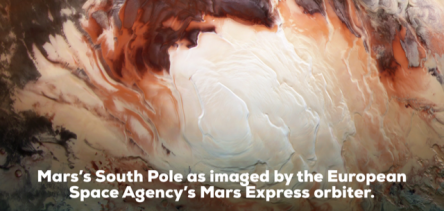 If you want to see surface features on Mars, you are going to need a telescope. Preferably a big telescope. The most detail on Mars that I have ever seen was when I had the good fortune of looking through UT Austin’s 82” Otto Struve Telescope at the McDonald Observatory in west Texas. But most of us don’t have access to that kind of equipment in our backyards, so what kind of instrumentation do you need? Any decent sized telescope (a minimum of 4” for a refractor and 6” for a reflector or catadioptric) with quality optics can reveal surface features. A good refractor will give you brighter, sharper images than will a reflector or catadioptric telescope. On the other hand, the latter two telescope types can afford you large apertures, ideal for gathering much more light than the former type. In a nutshell, the things that you are going to need on your side when it comes to observing Mars telescopically are: quality optics (use the highest magnification your telescope and seeing conditions will permit: 150x to 200x are generally just about right), patience, a steady atmosphere, luck, and good weather, both here on Earth and on Mars. Currently, Mars’ southern hemisphere is transitioning from spring to summer and this means that dust storms frequently pop up. As I sit here writing these words in late June one such dust storm has already developed and encompassed the entire globe of Mars. Dust storms on Mars are rather long lived and can last for weeks. Hopefully, this one will subside before opposition and we can get the chance to see details upon the surface.
If you want to see surface features on Mars, you are going to need a telescope. Preferably a big telescope. The most detail on Mars that I have ever seen was when I had the good fortune of looking through UT Austin’s 82” Otto Struve Telescope at the McDonald Observatory in west Texas. But most of us don’t have access to that kind of equipment in our backyards, so what kind of instrumentation do you need? Any decent sized telescope (a minimum of 4” for a refractor and 6” for a reflector or catadioptric) with quality optics can reveal surface features. A good refractor will give you brighter, sharper images than will a reflector or catadioptric telescope. On the other hand, the latter two telescope types can afford you large apertures, ideal for gathering much more light than the former type. In a nutshell, the things that you are going to need on your side when it comes to observing Mars telescopically are: quality optics (use the highest magnification your telescope and seeing conditions will permit: 150x to 200x are generally just about right), patience, a steady atmosphere, luck, and good weather, both here on Earth and on Mars. Currently, Mars’ southern hemisphere is transitioning from spring to summer and this means that dust storms frequently pop up. As I sit here writing these words in late June one such dust storm has already developed and encompassed the entire globe of Mars. Dust storms on Mars are rather long lived and can last for weeks. Hopefully, this one will subside before opposition and we can get the chance to see details upon the surface.
With just about any favorable opposition, Mars will reveal its polar ice caps for observers and, as the 2018 opposition date approaches, backyard telescope owners can expect to see the planet’s south pole tilted in our direction. As the hemisphere transitions from spring to summer, we will be able to see this ice cap composed of carbon dioxide and water ice, slowly shrink in size. By the way, ice on Mars does not melt, it “sublimates”. Because of the cold temperatures and thin atmosphere, ice transitions from a solid to a gas without going through a liquid state.
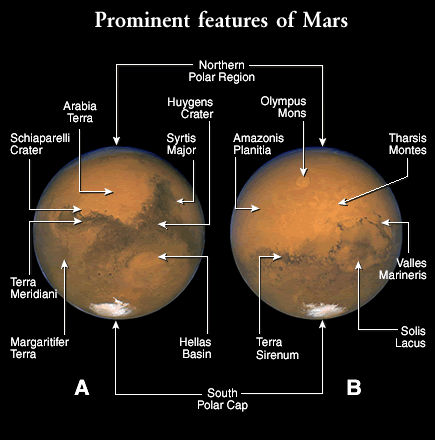 If you are fortunate to have some really good seeing, and your observing equipment is up for the challenge, you may get to see some contrasting light and dark markings on the planet’s surface. Astronomers call these “albedo features”, “albedo” simply being a word that refers to the fraction of the Sun’s light that gets reflected off of a celestial body’s surface or from individual surface features. On Mars, one albedo feature that you are most likely to see is called Syrtis Major and it will probably appear as a dark triangle-shaped blob. Once believed to be a vast plain, thanks to orbiting spacecraft, we now know that Syrtis Major is the remnants of an ancient shield volcano. You may get to see other albedo features as well and I have included a couple of photos of Mars with the most prominent features labeled. Don’t get discouraged if you do not see anything on your first night out with a telescope, keep trying. And keep in mind that Mars has a rotational period very close to that of Earth (about 37 minutes longer than our 24-hour day). One side of Mars does not have much in the way of well-defined albedo features, so, if you don’t see anything at one time of night, try a different time period on another night. Also, don’t go out and look for a few minutes and then throw in the towel, your window of good seeing could open at any moment so allow yourself a reasonable amount of time at the scope. Try using a red filter on your eyepiece to help bring out contrasts between the lighter and darker albedo features.
If you are fortunate to have some really good seeing, and your observing equipment is up for the challenge, you may get to see some contrasting light and dark markings on the planet’s surface. Astronomers call these “albedo features”, “albedo” simply being a word that refers to the fraction of the Sun’s light that gets reflected off of a celestial body’s surface or from individual surface features. On Mars, one albedo feature that you are most likely to see is called Syrtis Major and it will probably appear as a dark triangle-shaped blob. Once believed to be a vast plain, thanks to orbiting spacecraft, we now know that Syrtis Major is the remnants of an ancient shield volcano. You may get to see other albedo features as well and I have included a couple of photos of Mars with the most prominent features labeled. Don’t get discouraged if you do not see anything on your first night out with a telescope, keep trying. And keep in mind that Mars has a rotational period very close to that of Earth (about 37 minutes longer than our 24-hour day). One side of Mars does not have much in the way of well-defined albedo features, so, if you don’t see anything at one time of night, try a different time period on another night. Also, don’t go out and look for a few minutes and then throw in the towel, your window of good seeing could open at any moment so allow yourself a reasonable amount of time at the scope. Try using a red filter on your eyepiece to help bring out contrasts between the lighter and darker albedo features.
LIFE ON MARS?
 During the late 19th century, Italian astronomer Giovanni Schiaparelli observed dark, linear albedo features on Mars that he called “canali”, which, in Italian, means “channels”, as in naturally formed surface features. Unfortunately, a wealthy and rather eccentric Bostonian amateur astronomer named Percival Lowell, misinterpreted this to mean “canals”, which implies a structure made by an intelligence and with a purpose. Lowell became obsessed with the idea of a dying, intelligent race inhabiting Mars that were constructing vast irrigation networks on the planet’s surface. Lowell built a special observatory in Arizona in order to pursue his quest of proving the existence of these canals and his Martians. He even wrote best-selling popular books and gave presentations on the subject all around the world. While most professional astronomers scoffed at his ideas, they struck a chord with the public. Writers like H.G. Wells, Edgar Rice Burroughs, Ray Bradbury, and Robert Heinlein
During the late 19th century, Italian astronomer Giovanni Schiaparelli observed dark, linear albedo features on Mars that he called “canali”, which, in Italian, means “channels”, as in naturally formed surface features. Unfortunately, a wealthy and rather eccentric Bostonian amateur astronomer named Percival Lowell, misinterpreted this to mean “canals”, which implies a structure made by an intelligence and with a purpose. Lowell became obsessed with the idea of a dying, intelligent race inhabiting Mars that were constructing vast irrigation networks on the planet’s surface. Lowell built a special observatory in Arizona in order to pursue his quest of proving the existence of these canals and his Martians. He even wrote best-selling popular books and gave presentations on the subject all around the world. While most professional astronomers scoffed at his ideas, they struck a chord with the public. Writers like H.G. Wells, Edgar Rice Burroughs, Ray Bradbury, and Robert Heinlein  wrote many a fantastic science fiction story inspired by Lowell’s ideas of Martians and the idea has remained in our collective consciousness ever since.
wrote many a fantastic science fiction story inspired by Lowell’s ideas of Martians and the idea has remained in our collective consciousness ever since.
Of course, we now know that Schiaparelli and Lowell’s canals were just optical illusions and that Martians do not exist. At least not the science fictional variety.
Today, Mars is a cold, dry place where liquid water does not exist at the surface. The average temperature on the Red Planet is about -67 degrees Fahrenheit while surface temperatures at the equator may be a pleasant 68 F at noon but then dropping down to -243 F at the polar regions. These cold temperatures, coupled with an atmosphere that is 100 times thinner than here on Earth, means that water at the surface would either freeze solid or sublimate away into the atmosphere.
But we have compelling, multiple lines of evidence to suggest that billions of years ago, Mars had a thicker atmosphere, warmer temperatures, and plentiful liquid water at the surface. It also had complex organic chemistry. All the ingredients needed for life as we know it here on Earth today. But, at some point, Mars’ interior cooled to the point that it could no longer produce the magnetic fields that act as shields to protect the surface from the onslaught of the solar wind. Over time, the Martian  atmosphere eroded away and brought with it, colder temperatures and puny atmospheric pressures. Could life have evolved on Mars during those halcyon days of a warmer, wetter climate? Maybe. Could it still exist somewhere on the surface or subsurface? Possibly. Will we ever send humans there to find out for sure? I’m almost certain that we will.
atmosphere eroded away and brought with it, colder temperatures and puny atmospheric pressures. Could life have evolved on Mars during those halcyon days of a warmer, wetter climate? Maybe. Could it still exist somewhere on the surface or subsurface? Possibly. Will we ever send humans there to find out for sure? I’m almost certain that we will.
Can we ever live permanently on Mars? Not as it exists now, but, maybe over the next 100 years, we can find a way. We will have to if we plan to perpetuate our species into the distant future, for one day, the Earth will no longer be habitable, either by our own action or through some kind of cataclysm. But do we have the moral right to colonize another world? If there is life there, do we have the right to jeopardize its existence for our own? Do we have the right to take on all of the risks and expense to create a future generation of humans who will likely never be able to know their own home world? 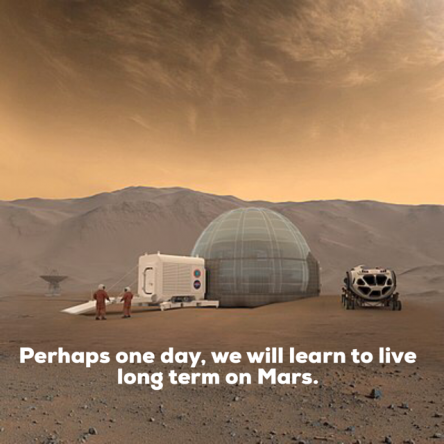 I don’t know the answers to these questions, but they are ones that we should grapple with before we attempt any kind of permanent human presence on the Red Planet. Either way, these are some things you may want to ponder for yourself as you get outside and look up this Martian summer.
I don’t know the answers to these questions, but they are ones that we should grapple with before we attempt any kind of permanent human presence on the Red Planet. Either way, these are some things you may want to ponder for yourself as you get outside and look up this Martian summer.
Don’t forget that you can check out telescopes from both the Central Arkansas Library System and the Laman Library in North Little Rock. These small telescopes, combined with good seeing conditions, may allow you to at least see Mars’ polar ice caps. You can learn about the CALS telescope program here: https://cals.org/telescope-lending/
If you cannot access a telescope, then consider coming to a monthly club meeting or a star party hosted by the Central Arkansas Astronomical Society: http://www.caasastro.org/event-schedules/calendar/
Or, the Sugar Creek Astronomical Society in northwest Arkansas: https://www.sugarcreek.space